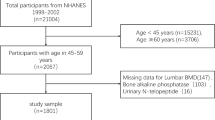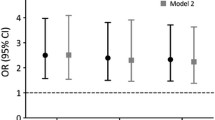Abstract
Summary
The aim of this study was to determine whether bone turnover markers (BTMs) predict changes in areal bone mineral density (aBMD) in middle-aged and elderly European men. Older men with high bone turnover are at a higher risk of accelerated hip bone loss, but the clinical utility of BTMs in individuals is limited.
Introduction
Prospective studies on the value of BTMs to predict changes in aBMD in men are few and conflicting. The aim of this study was to determine whether BTMs predict changes in aBMD in middle-aged and elderly European men.
Methods
In 487 men aged 40–79 years from the European Male Ageing Study (EMAS), BTMs were assessed at baseline and dual-energy X-ray absorptiometry (DXA) at the lumbar spine (LS), femoral neck (FN) and total hip (TH) was performed at baseline and after a mean follow-up of 4.3 years.
Results
The mean aBMD decreased by 0.32 %/year at FN and 0.22 %/year at TH and increased by 0.32 %/year at LS. Higher baseline levels of β C-terminal cross-linked telopeptide (β-CTX) and N-terminal propeptide of type I procollagen (PINP) were significantly associated with higher loss of hip aBMD in the whole cohort and men aged 60–79 years. These associations remained significant after adjustment for age, centre and body mass index (BMI). Men aged 60–79 years with β-CTX in the upper quintile were more likely of being in the upper quintile of annual percentage (%) aBMD loss at FN (OR = 4.27; 95% CI = 2.09–8.73) and TH (OR = 3.73; 95% CI = 1.84–7.57). The positive predictive value (PPV) was 46 % at both hip sites.
Conclusion
Older men with high bone turnover have a higher risk of accelerated hip bone loss, but the PPV is low. BTMs are therefore unlikely to be of clinical utility in predicting accelerated hip bone loss in individual subjects.

Similar content being viewed by others
References
Johnell O, Kanis JA (2006) An estimate of the worldwide prevalence and disability associated with osteoporotic fractures. Osteoporos Int 17(12):1726–1733
Center JR, Nguyen TV, Schneider D, Sambrook PN, Eisman JA (1999) Mortality after all major types of osteoporotic fracture in men and women: an observational study. Lancet 353(9156):878–882
Khosla S, Amin S, Orwoll E (2008) Osteoporosis in men. Endocr Rev 29(4):441–464
Vasikaran S, Eastell R, Bruyere O, Foldes AJ, Garnero P, Griesmacher A, McClung M, Morris HA, Silverman S, Trenti T, Wahl DA, Cooper C, Kanis JA, Group I-IBMSW (2011) Markers of bone turnover for the prediction of fracture risk and monitoring of osteoporosis treatment: a need for international reference standards. Osteoporos Int 22(2):391–420
Naylor K, Eastell R (2012) Bone turnover markers: use in osteoporosis. Nat Rev Rheumatol 8(7):379–389
Szulc P, Montella A, Delmas PD (2008) High bone turnover is associated with accelerated bone loss but not with increased fracture risk in men aged 50 and over: the prospective MINOS study. Ann Rheum Dis 67(9):1249–1255
Bauer DC, Garnero P, Harrison SL, Cauley JA, Eastell R, Ensrud KE, Orwoll E, Osteoporotic Fractures in Men Research G (2009) Biochemical markers of bone turnover, hip bone loss, and fracture in older men: the MrOS study. J Bone Miner Res 24(12):2032–2038
Dennison E, Eastell R, Fall CH, Kellingray S, Wood PJ, Cooper C (1999) Determinants of bone loss in elderly men and women: a prospective population-based study. Osteoporos Int 10(5):384–391
Meier C, Nguyen TV, Center JR, Seibel MJ, Eisman JA (2005) Bone resorption and 24 osteoporotic fractures in elderly men: the dubbo osteoporosis epidemiology study. J Bone Miner Res 20(4):579–587
Yoshimura N, Hashimoto T, Sakata K, Morioka S, Kasamatsu T, Cooper C (1999) Biochemical markers of bone turnover and bone loss at the lumbar spine and femoral neck: the Taiji study. Calcif Tissue Int 65(3):198–202
Yoshimura N, Muraki S, Oka H, Kawaguchi H, Nakamura K, Akune T (2011) Biochemical markers of bone turnover as predictors of osteoporosis and osteoporotic fractures in men and women: 10-year follow-up of the Taiji cohort. Mod Rheumatol 21(6):608–620
Scopacasa F, Wishart JM, Need AG, Horowitz M, Morris HA, Nordin BE (2002) Bone density and bone-related biochemical variables in normal men: a longitudinal study. J Gerontol A: Biol Med Sci 57(6):M385–M391
Szulc P (2011) Biochemical bone turnover markers and osteoporosis in older men: where are we? J Osteoporos 2011:704015
Nguyen TV, Meier C, Center JR, Eisman JA, Seibel MJ (2007) Bone turnover in elderly men: relationships to change in bone mineral density. BMC Musculoskelet Disord 8:13
Boonen S, Pye SR, O’Neill TW, Szulc P, Gielen E, Borghs H, Verschueren S, Claessens F, Adams JE, Ward KA, Bartfai G, Casanueva F, Finn JD, Forti G, Giwercman A, Han TS, Huhtaniemi IT, Kula K, Labrie F, Lean ME, Pendleton N, Punab M, Silman AJ, Tajar A, Wu FC, Vanderschueren D, Group E (2011) Influence of bone remodelling rate on quantitative ultrasound parameters at the calcaneus and DXA BMDa of the hip and spine in middle-aged and elderly European men: the European Male Ageing Study (EMAS). Eur J Endocrinol 165(6):977–986
Lee DM, O’Neill TW, Pye SR, Silman AJ, Finn JD, Pendleton N, Tajar A, Bartfai G, Casanueva F, Forti G, Giwercman A, Huhtaniemi IT, Kula K, Punab M, Boonen S, Vanderschueren D, Wu FC, group Es (2009) The European Male Ageing Study (EMAS): design, methods and recruitment. Int J Androl 32(1):11–24
Lee DM, Pye SR, Tajar A, O’Neill TW, Finn JD, Boonen S, Bartfai G, Casanueva FF, Forti G, Giwercman A, Han TS, Huhtaniemi IT, Kula K, Lean ME, Pendleton N, Punab M, Silman AJ, Vanderschueren D, Wu FC, Group ES (2013) Cohort profile: the European Male Ageing Study. Int J Epidemiol 42(2):391–401
Washburn RA, Smith KW, Jette AM, Janney CA (1993) The Physical Activity Scale for the Elderly (PASE): development and evaluation. J Clin Epidemiol 46(2):153–162
Vanderschueren D, Pye SR, O’Neill TW, Lee DM, Jans I, Billen J, Gielen E, Laurent M, Claessens F, Adams JE, Ward KA, Bartfai G, Casanueva FF, Finn JD, Forti G, Giwercman A, Han TS, Huhtaniemi IT, Kula K, Lean ME, Pendleton N, Punab M, Wu FC, Boonen S, Group ES (2013) Active vitamin D (1,25-dihydroxyvitamin D) and bone health in middle-aged and elderly men: the European Male Aging Study (EMAS). J Clin Endocrinol Metab 98(3):995–1005
Garnero P, Borel O, Delmas PD (2001) Evaluation of a fully automated serum assay for C-terminal cross-linking telopeptide of type I collagen in osteoporosis. Clin Chem 47(4):694–702
Garnero P, Vergnaud P, Hoyle N (2008) Evaluation of a fully automated serum assay for total N-terminal propeptide of type I collagen in postmenopausal osteoporosis. Clin Chem 54(1):188–196
Labrie F, Belanger A, Belanger P, Berube R, Martel C, Cusan L, Gomez J, Candas B, Castiel I, Chaussade V, Deloche C, Leclaire J (2006) Androgen glucuronides, instead of testosterone, as the new markers of androgenic activity in women. J Steroid Biochem Mol Biol 99(4–5):182–188
Labrie F, Belanger A, Belanger P, Berube R, Martel C, Cusan L, Gomez J, Candas B, Chaussade V, Castiel I, Deloche C, Leclaire J (2007) Metabolism of DHEA in postmenopausal women following percutaneous administration. J Steroid Biochem Mol Biol 103(2):178–188
Wu FC, Tajar A, Pye SR, Silman AJ, Finn JD, O’Neill TW, Bartfai G, Casanueva F, Forti G, Giwercman A, Huhtaniemi IT, Kula K, Punab M, Boonen S, Vanderschueren D, European Male Aging Study G (2008) Hypothalamic-pituitary-testicular axis disruptions in older men are differentially linked to age and modifiable risk factors: the European Male Aging Study. J Clin Endocrinol Metab 93(7):2737–2745
Van Pottelbergh I, Goemaere S, Kaufman JM (2003) Bioavailable estradiol and an aromatase gene polymorphism are determinants of bone mineral density changes in men over 70 years of age. J Clin Endocrinol Metab 88(7):3075–3081
Vermeulen A, Verdonck L, Kaufman JM (1999) A critical evaluation of simple methods for the estimation of free testosterone in serum. J Clin Endocrinol Metab 84(10):3666–3672
Reid DM, Mackay I, Wilkinson S, Miller C, Schuette DG, Compston J, Cooper C, Duncan E, Galwey N, Keen R, Langdahl B, McLellan A, Pols H, Uitterlinden A, O’Riordan J, Wass JA, Ralston SH, Bennett ST (2006) Cross-calibration of dual-energy X-ray densitometers for a large, multi-center genetic study of osteoporosis. Osteoporos Int 17(1):125–132
Seeman E (2002) Pathogenesis of bone fragility in women and men. Lancet 359(9320):1841–1850
Seeman E, Delmas PD (2006) Bone quality—the material and structural basis of bone strength and fragility. N Engl J Med 354(21):2250–2261
Seeman E (2003) Reduced bone formation and increased bone resorption: rational targets for the treatment of osteoporosis. Osteoporos Int 14(Suppl 3):S2–S8
Seeman E (2003) Invited review: pathogenesis of osteoporosis. J Appl Physiol (1985) 95(5):2142–2151
Burger H, de Laet CE, van Daele PL, Weel AE, Witteman JC, Hofman A, Pols HA (1998) Risk factors for increased bone loss in an elderly population: the Rotterdam Study. Am J Epidemiol 147(9):871–879
Cawthon PM, Ewing SK, McCulloch CE, Ensrud KE, Cauley JA, Cummings SR, Orwoll ES, Osteoporotic Fractures in Men Research G (2009) Loss of hip BMD in older men: the osteoporotic fractures in men (MrOS) study. J Bone Miner Res 24(10):1728–1735
Lenora J, Ivaska KK, Obrant KJ, Gerdhem P (2007) Prediction of bone loss using biochemical markers of bone turnover. Osteoporos Int 18(9):1297–1305
Szulc P, Garnero P, Munoz F, Marchand F, Delmas PD (2001) Cross-sectional evaluation of bone metabolism in men. J Bone Miner Res 16(9):1642–1650
Gennari L, Merlotti D, Martini G, Gonnelli S, Franci B, Campagna S, Lucani B, Dal Canto N, Valenti R, Gennari C, Nuti R (2003) Longitudinal association between sex hormone levels, bone loss, and bone turnover in elderly men. J Clin Endocrinol Metab 88(11):5327–5333
Wu FCW, Tajar A, Beynon JM, Pye SR, Silman AJ, Finn JD, O’Neill TW, Bartfai G, Casanueva FF, Forti G, Giwercman A, Han TS, Kula K, Lean MEJ, Pendleton N, Punab M, Boonen S, Vanderschueren D, Labrie F, Huhtaniemi IT, Grp E (2010) Identification of late-onset hypogonadism in middle-aged and elderly men. N Engl J Med 363(2):123–135
Acknowledgments
This work is dedicated to the memory of Prof. Dr. Steven Boonen.
The European Male Ageing Study (EMAS) was funded by the Commission of the European Communities Fifth Framework Programme Quality of Life and Management of Living Resources grant QLK6-CT-2001-00258. This work was also supported by grant G.0488.08 from the Fund for Scientific Research (FWO-Vlaanderen) to SB, research grants OT-05-53, OT-09-035 and OT-11-081 from the KU Leuven to DV and research funding from Arthritis Research UK. DV is a senior clinical investigator of the Leuven University Hospital Clinical Research Fund. ML is a fellow of the Research Foundation Flanders. KW is funded by the UK Medical Research Council, programme number U105960371.
Conflicts of interest
None.
Author information
Authors and Affiliations
Corresponding author
Electronic supplementary material
Below is the link to the electronic supplementary material.
ESM 1
(DOC 28 kb)
Rights and permissions
About this article
Cite this article
Gielen, E., O’Neill, T., Pye, S. et al. Bone turnover markers predict hip bone loss in elderly European men: results of the European Male Ageing Study (EMAS). Osteoporos Int 26, 617–627 (2015). https://doi.org/10.1007/s00198-014-2884-1
Received:
Accepted:
Published:
Issue Date:
DOI: https://doi.org/10.1007/s00198-014-2884-1




